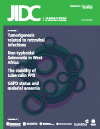Non-Hodgkin lymphoma of bone in an HIV-infected patient from Argentina
DOI:
https://doi.org/10.3855/jidc.1868Keywords:
AIDS-related lymphoma, AIDS, HIV infection, non-Hodgkin lymphomaAbstract
Introduction: Human immunodeficiency virus (HIV)-infected patients are at higher risk for development of Non-Hodgkin's lymphoma (NHL). The estimated incidence of NHL in patients with acquired immunodeficiency syndrome (AIDS) is much higher when compared to the general population. Most AIDS-associated NHL are of intermediate- or high-grade B-cell type and involve extranodal sites more frequently. The most common sites are the central nervous system (CNS), gastrointestinal tract, liver, bone marrow and soft tissues.
Methodology: We describe a 42-year-old male with risk factors for HIV infection who presented with left leg pain and an osteolytic lesion of the left medial tibia. He was subsequently diagnosed with HIV disease and an open biopsy of his left tibia established the diagnosis of NHL.
Results: After starting antiretroviral therapy followed by chemotherapy he achieved remission.
Conclusion: Bone lymphomas account for 3% of malignant bone tumors and 4-7% of all extranodal sites. NHL of bone has been infrequently described in patients with AIDS. To our knowledge, this is the first report of NHL of the bone in Argentina.
Downloads
Published
How to Cite
Issue
Section
License
Authors who publish with this journal agree to the following terms:
- Authors retain copyright and grant the journal right of first publication with the work simultaneously licensed under a Creative Commons Attribution License that allows others to share the work with an acknowledgement of the work's authorship and initial publication in this journal.
- Authors are able to enter into separate, additional contractual arrangements for the non-exclusive distribution of the journal's published version of the work (e.g., post it to an institutional repository or publish it in a book), with an acknowledgement of its initial publication in this journal.
- Authors are permitted and encouraged to post their work online (e.g., in institutional repositories or on their website) prior to and during the submission process, as it can lead to productive exchanges, as well as earlier and greater citation of published work (See The Effect of Open Access).








